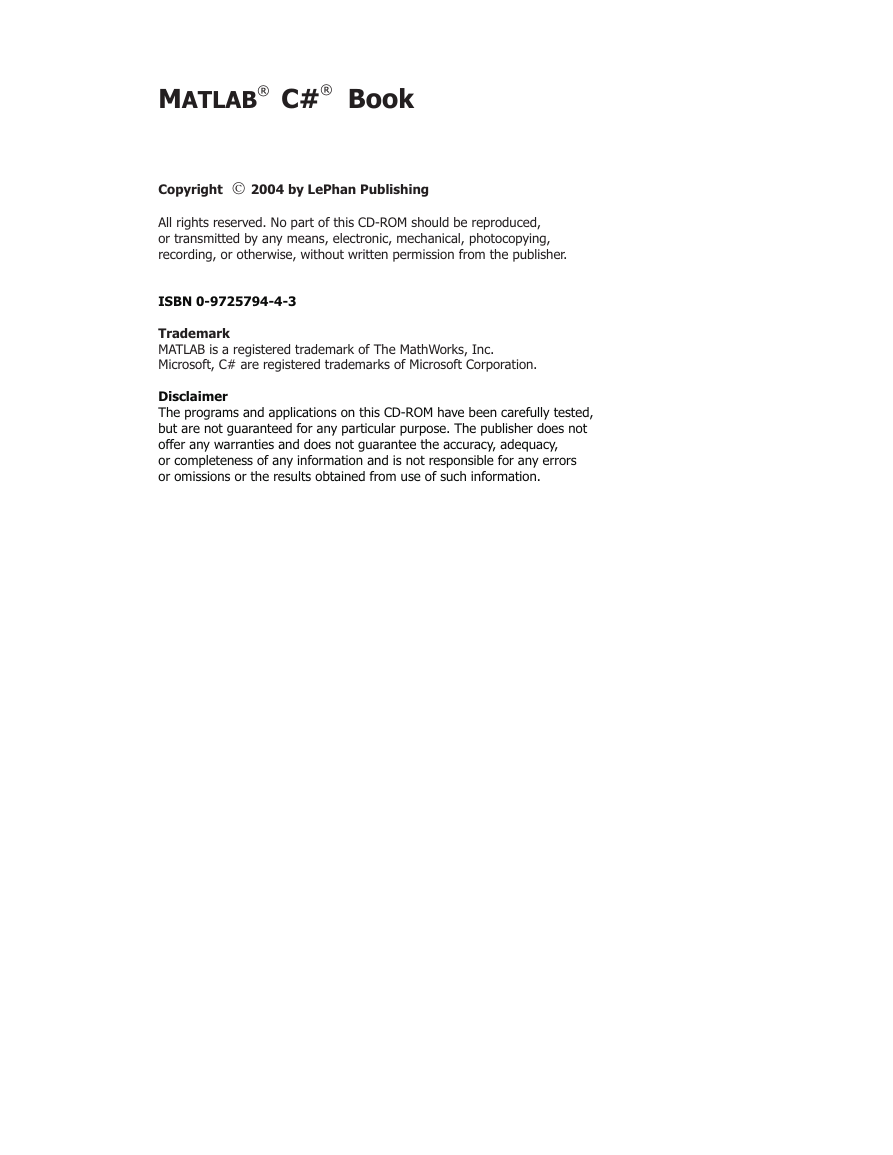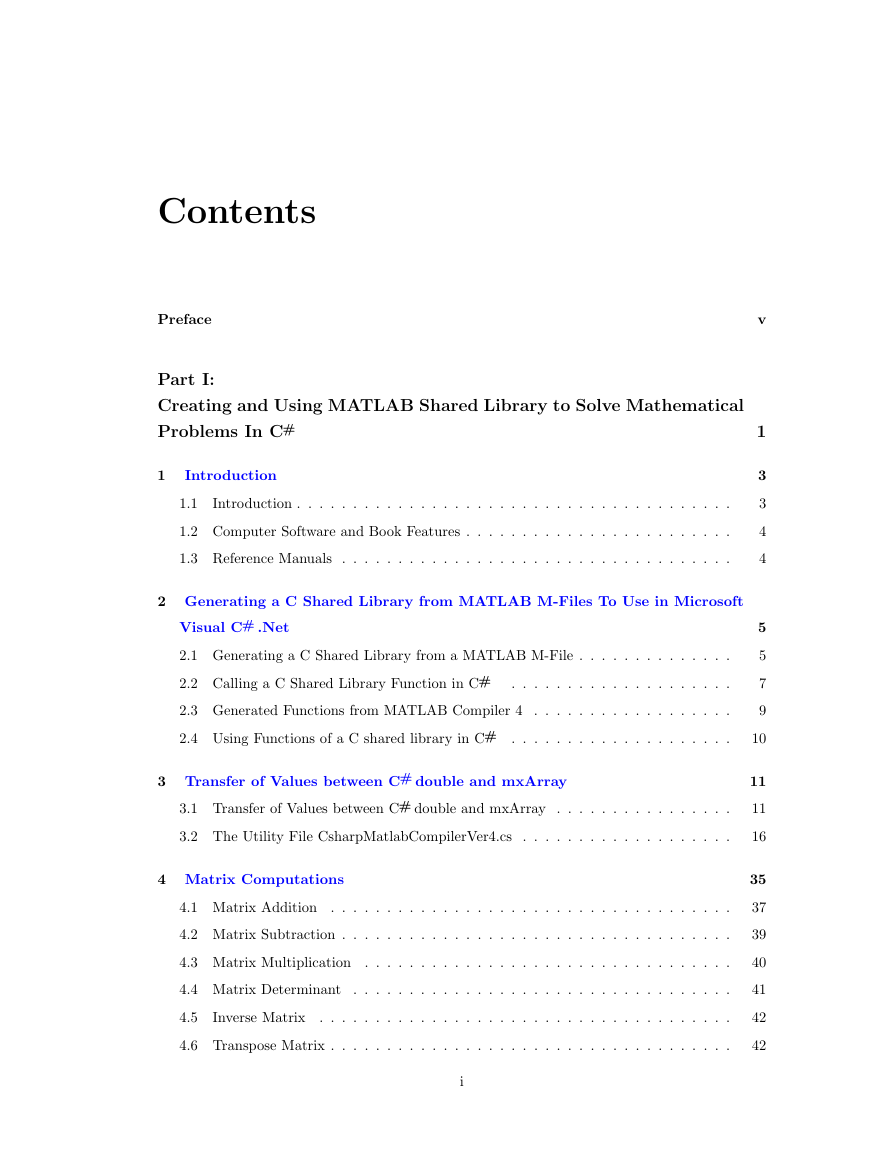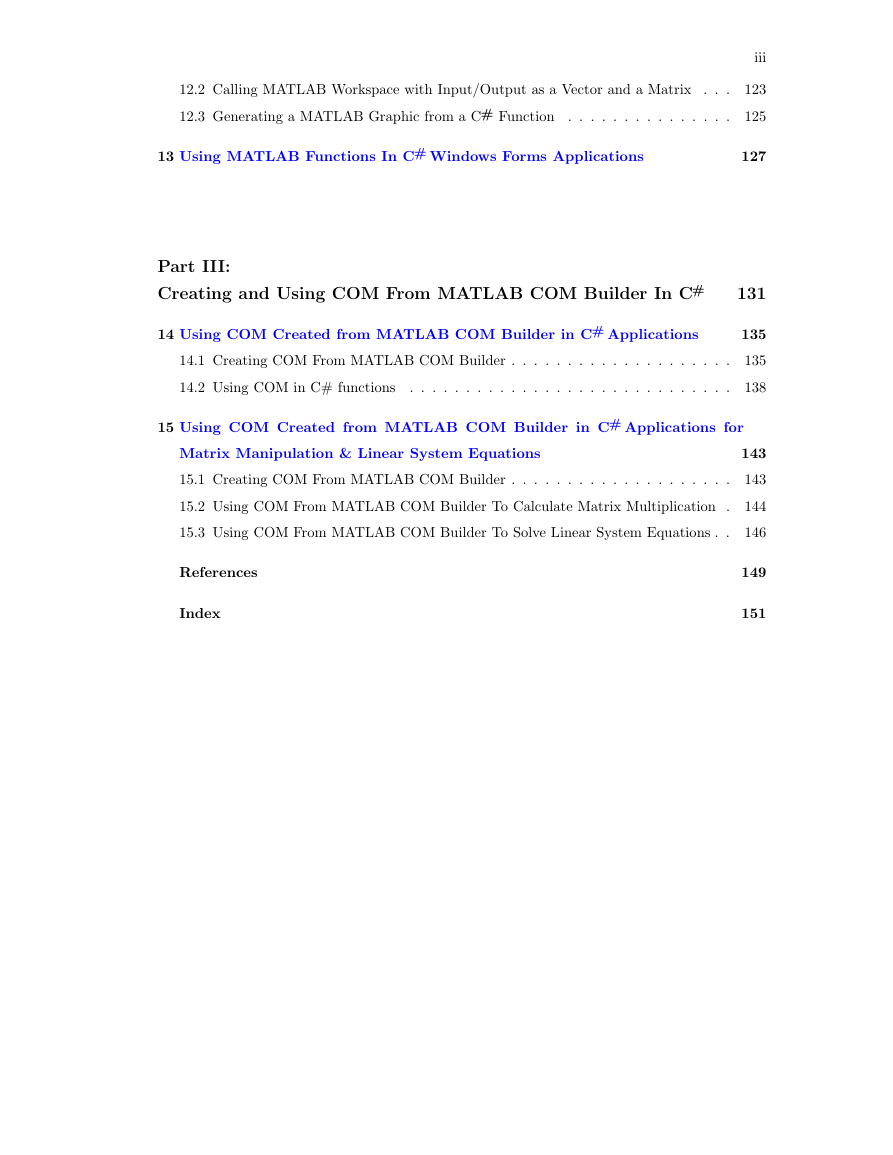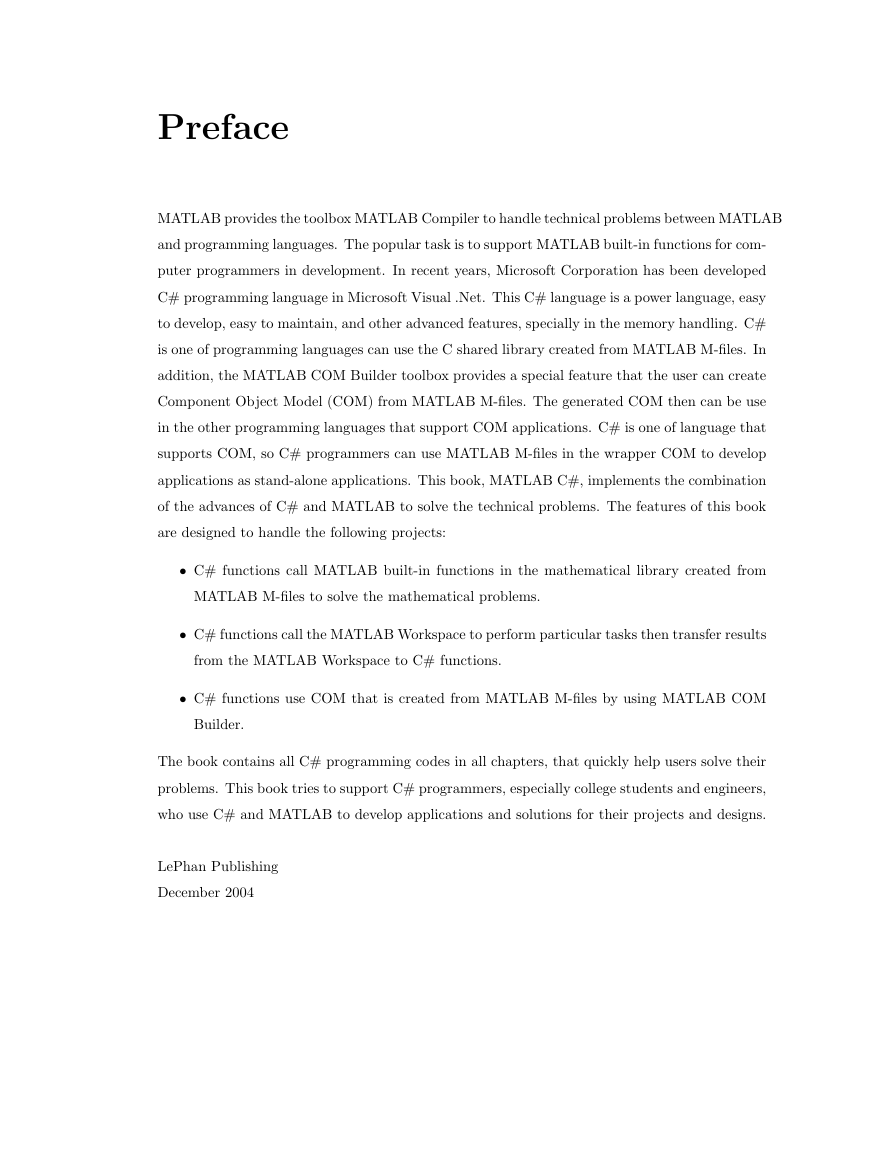F
i
r
s
t
E
d
i
t
i
o
n
T
h
i
s
b
o
o
k
i
s
a
g
r
e
a
t
t
u
t
o
r
i
a
l
f
o
r
C
#
p
r
o
g
r
a
m
m
e
r
s
w
h
o
u
s
e
M
A
T
L
A
B
t
o
d
e
v
e
l
o
p
a
p
p
l
i
c
a
t
i
o
n
s
a
n
d
s
o
l
u
t
i
o
n
s
M
A
T
L
A
B
C
#
®
®
B
o
o
k
�
®
A
l
l
r
i
g
h
t
s
r
e
s
e
r
v
e
d
.
N
o
p
a
r
t
o
f
t
h
i
s
C
D
-
R
O
M
s
h
o
u
l
d
b
e
r
e
p
r
o
d
u
c
e
d
,
o
r
t
r
a
n
s
m
i
t
t
e
d
b
y
a
n
y
m
e
a
n
s
,
e
l
e
c
t
r
o
n
i
c
,
m
e
c
h
a
n
i
c
a
l
,
p
h
o
t
o
c
o
p
y
i
n
g
,
r
e
c
o
r
d
i
n
g
,
o
r
o
t
h
e
r
w
i
s
e
,
w
i
t
h
o
u
t
w
r
i
t
t
e
n
p
e
r
m
i
s
s
i
o
n
f
r
o
m
t
h
e
p
u
b
l
i
s
h
e
r
.
M
C
#
B
o
o
k
A
T
L
A
B
C
o
p
y
r
i
g
h
t
2
0
0
4
b
y
L
e
P
h
a
n
P
u
b
l
i
s
h
i
n
g
®
M
A
T
L
A
B
i
s
a
r
e
g
i
s
t
e
r
e
d
t
r
a
d
e
m
a
r
k
o
f
T
h
e
M
a
t
h
W
o
r
k
s
,
I
n
c
.
M
i
c
r
o
s
o
f
t
,
C
#
a
r
e
r
e
g
i
s
t
e
r
e
d
t
r
a
d
e
m
a
r
k
s
o
f
M
i
c
r
o
s
o
f
t
C
o
r
p
o
r
a
t
i
o
n
.
Ó
T
r
a
d
e
m
a
r
k
T
h
e
p
r
o
g
r
a
m
s
a
n
d
a
p
p
l
i
c
a
t
i
o
n
s
o
n
t
h
i
s
C
D
-
R
O
M
h
a
v
e
b
e
e
n
c
a
r
e
f
u
l
l
y
t
e
s
t
e
d
,
b
u
t
a
r
e
n
o
t
g
u
a
r
a
n
t
e
e
d
f
o
r
a
n
y
p
a
r
t
i
c
u
l
a
r
p
u
r
p
o
s
e
.
T
h
e
p
u
b
l
i
s
h
e
r
d
o
e
s
n
o
t
o
f
f
e
r
a
n
y
w
a
r
r
a
n
t
i
e
s
a
n
d
d
o
e
s
n
o
t
g
u
a
r
a
n
t
e
e
t
h
e
a
c
c
u
r
a
c
y
,
a
d
e
q
u
a
c
y
,
o
r
c
o
m
p
l
e
t
e
n
e
s
s
o
f
a
n
y
i
n
f
o
r
m
a
t
i
o
n
a
n
d
i
s
n
o
t
r
e
s
p
o
n
s
i
b
l
e
f
o
r
a
n
y
e
r
r
o
r
s
o
r
o
m
i
s
s
i
o
n
s
o
r
t
h
e
r
e
s
u
l
t
s
o
b
t
a
i
n
e
d
f
r
o
m
u
s
e
o
f
s
u
c
h
i
n
f
o
r
m
a
t
i
o
n
.
I
S
B
N
0
-
9
7
2
5
7
9
4
-
4
-
3
D
i
s
c
l
a
i
m
e
r
�
Contents
Preface
Part I:
Creating and Using MATLAB Shared Library to Solve Mathematical
Problems In C#
1
Introduction
1.1
Introduction . . . . . . . . . . . . . . . . . . . . . . . . . . . . . . . . . . . . . . .
1.2 Computer Software and Book Features . . . . . . . . . . . . . . . . . . . . . . . .
1.3 Reference Manuals . . . . . . . . . . . . . . . . . . . . . . . . . . . . . . . . . . .
2 Generating a C Shared Library from MATLAB M-Files To Use in Microsoft
Visual C# .Net
2.1 Generating a C Shared Library from a MATLAB M-File . . . . . . . . . . . . . .
2.2 Calling a C Shared Library Function in C# . . . . . . . . . . . . . . . . . . . .
2.3 Generated Functions from MATLAB Compiler 4 . . . . . . . . . . . . . . . . . .
v
1
3
3
4
4
5
5
7
9
2.4 Using Functions of a C shared library in C# . . . . . . . . . . . . . . . . . . . .
10
3 Transfer of Values between C# double and mxArray
3.1 Transfer of Values between C# double and mxArray . . . . . . . . . . . . . . . .
3.2 The Utility File CsharpMatlabCompilerVer4.cs . . . . . . . . . . . . . . . . . . .
4 Matrix Computations
4.1 Matrix Addition . . . . . . . . . . . . . . . . . . . . . . . . . . . . . . . . . . . .
4.2 Matrix Subtraction . . . . . . . . . . . . . . . . . . . . . . . . . . . . . . . . . . .
4.3 Matrix Multiplication . . . . . . . . . . . . . . . . . . . . . . . . . . . . . . . . .
4.4 Matrix Determinant
. . . . . . . . . . . . . . . . . . . . . . . . . . . . . . . . . .
4.5
Inverse Matrix . . . . . . . . . . . . . . . . . . . . . . . . . . . . . . . . . . . . .
4.6 Transpose Matrix . . . . . . . . . . . . . . . . . . . . . . . . . . . . . . . . . . . .
11
11
16
35
37
39
40
41
42
42
i
�
ii
5 Linear System Equations
5.1 Linear System Equations
. . . . . . . . . . . . . . . . . . . . . . . . . . . . . . .
5.2 Sparse Linear System . . . . . . . . . . . . . . . . . . . . . . . . . . . . . . . . .
5.3 Tridiagonal System Equations . . . . . . . . . . . . . . . . . . . . . . . . . . . . .
5.4 Band Diagonal System Equations . . . . . . . . . . . . . . . . . . . . . . . . . . .
6 Ordinary Dierential Equations
6.1 First Order ODE . . . . . . . . . . . . . . . . . . . . . . . . . . . . . . . . . . . .
6.2 Second Order ODE . . . . . . . . . . . . . . . . . . . . . . . . . . . . . . . . . . .
6.2.1 Analysis of second order ODE . . . . . . . . . . . . . . . . . . . . . . . . .
6.2.2 Using a second order ODE function . . . . . . . . . . . . . . . . . . . . .
7 Integration
7.1 Single Integration . . . . . . . . . . . . . . . . . . . . . . . . . . . . . . . . . . . .
7.2 Double-Integration . . . . . . . . . . . . . . . . . . . . . . . . . . . . . . . . . . .
8 Curve Fitting and Interpolations
8.1 Polynomial Curve Fitting . . . . . . . . . . . . . . . . . . . . . . . . . . . . . . .
8.2 One-Dimensional Polynomial Interpolation . . . . . . . . . . . . . . . . . . . . .
8.3 Two-Dimensional Polynomial Interpolation for Grid Points
. . . . . . . . . . . .
9 Roots of Equations
9.1 Roots of Polynomials . . . . . . . . . . . . . . . . . . . . . . . . . . . . . . . . . .
43
45
49
52
56
61
63
69
69
70
73
74
78
81
83
87
88
97
98
9.2 The Root of a Nonlinear-Equation . . . . . . . . . . . . . . . . . . . . . . . . . .
101
10 Fast Fourier Transform
103
10.1 One-Dimensional Fast Fourier Transform . . . . . . . . . . . . . . . . . . . . . .
105
10.2 Two-Dimensional Fast Fourier Transform . . . . . . . . . . . . . . . . . . . . . .
109
11 Eigenvalues and Eigenvectors
113
11.1 Eigenvalues and Eigenvectors . . . . . . . . . . . . . . . . . . . . . . . . . . . . .
114
Part II:
Calling MATLAB Workspace in C# Functions
Using MATLAB functions in C# Windows Form Applications
12 Calling MATLAB Workspace in C# Functions
119
121
12.1 Calling MATLAB Workspace with Input/Output as a Scalar
. . . . . . . . . . .
121
�
12.2 Calling MATLAB Workspace with Input/Output as a Vector and a Matrix . . .
123
12.3 Generating a MATLAB Graphic from a C# Function . . . . . . . . . . . . . . .
125
13 Using MATLAB Functions In C# Windows Forms Applications
127
iii
Part III:
Creating and Using COM From MATLAB COM Builder In C#
131
14 Using COM Created from MATLAB COM Builder in C# Applications
135
14.1 Creating COM From MATLAB COM Builder . . . . . . . . . . . . . . . . . . . .
135
14.2 Using COM in C# functions
. . . . . . . . . . . . . . . . . . . . . . . . . . . . .
138
15 Using COM Created from MATLAB COM Builder in C# Applications for
Matrix Manipulation & Linear System Equations
143
15.1 Creating COM From MATLAB COM Builder . . . . . . . . . . . . . . . . . . . .
143
15.2 Using COM From MATLAB COM Builder To Calculate Matrix Multiplication .
144
15.3 Using COM From MATLAB COM Builder To Solve Linear System Equations . .
146
References
Index
149
151
�
iv
�
Preface
MATLAB provides the toolbox MATLAB Compiler to handle technical problems between MATLAB
and programming languages. The popular task is to support MATLAB built-in functions for com-
puter programmers in development. In recent years, Microsoft Corporation has been developed
C# programming language in Microsoft Visual .Net. This C# language is a power language, easy
to develop, easy to maintain, and other advanced features, specially in the memory handling. C#
is one of programming languages can use the C shared library created from MATLAB M-les. In
addition, the MATLAB COM Builder toolbox provides a special feature that the user can create
Component Object Model (COM) from MATLAB M-les. The generated COM then can be use
in the other programming languages that support COM applications. C# is one of language that
supports COM, so C# programmers can use MATLAB M-les in the wrapper COM to develop
applications as stand-alone applications. This book, MATLAB C#, implements the combination
of the advances of C# and MATLAB to solve the technical problems. The features of this book
are designed to handle the following projects:
C# functions call MATLAB built-in functions in the mathematical library created from
MATLAB M-les to solve the mathematical problems.
C# functions call the MATLAB Workspace to perform particular tasks then transfer results
from the MATLAB Workspace to C# functions.
C# functions use COM that is created from MATLAB M-les by using MATLAB COM
Builder.
The book contains all C# programming codes in all chapters, that quickly help users solve their
problems. This book tries to support C# programmers, especially college students and engineers,
who use C# and MATLAB to develop applications and solutions for their projects and designs.
LePhan Publishing
December 2004
�
vi
�
















 2023年江西萍乡中考道德与法治真题及答案.doc
2023年江西萍乡中考道德与法治真题及答案.doc 2012年重庆南川中考生物真题及答案.doc
2012年重庆南川中考生物真题及答案.doc 2013年江西师范大学地理学综合及文艺理论基础考研真题.doc
2013年江西师范大学地理学综合及文艺理论基础考研真题.doc 2020年四川甘孜小升初语文真题及答案I卷.doc
2020年四川甘孜小升初语文真题及答案I卷.doc 2020年注册岩土工程师专业基础考试真题及答案.doc
2020年注册岩土工程师专业基础考试真题及答案.doc 2023-2024学年福建省厦门市九年级上学期数学月考试题及答案.doc
2023-2024学年福建省厦门市九年级上学期数学月考试题及答案.doc 2021-2022学年辽宁省沈阳市大东区九年级上学期语文期末试题及答案.doc
2021-2022学年辽宁省沈阳市大东区九年级上学期语文期末试题及答案.doc 2022-2023学年北京东城区初三第一学期物理期末试卷及答案.doc
2022-2023学年北京东城区初三第一学期物理期末试卷及答案.doc 2018上半年江西教师资格初中地理学科知识与教学能力真题及答案.doc
2018上半年江西教师资格初中地理学科知识与教学能力真题及答案.doc 2012年河北国家公务员申论考试真题及答案-省级.doc
2012年河北国家公务员申论考试真题及答案-省级.doc 2020-2021学年江苏省扬州市江都区邵樊片九年级上学期数学第一次质量检测试题及答案.doc
2020-2021学年江苏省扬州市江都区邵樊片九年级上学期数学第一次质量检测试题及答案.doc 2022下半年黑龙江教师资格证中学综合素质真题及答案.doc
2022下半年黑龙江教师资格证中学综合素质真题及答案.doc